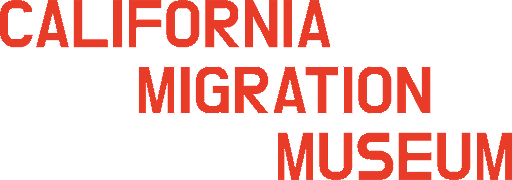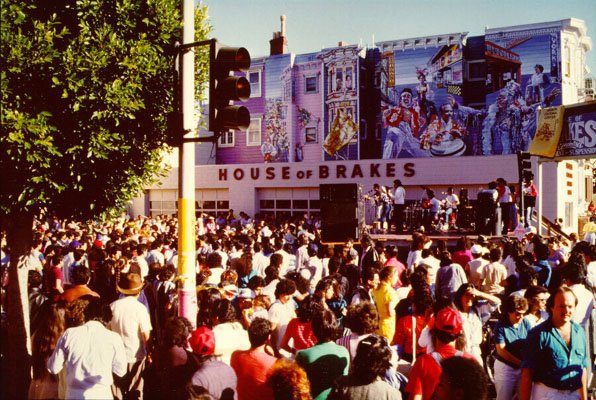The Mission
Beginnings
Mission Dolores, lithograph 1849
The Mission is one of San Francisco’s oldest and most celebrated neighborhoods. Today, you can still find street art and $5 burritos in the Mission – and you can also find designer clothing and $7 lattes. These fault lines aren’t new: from its earliest beginnings, the Mission has been a place where more powerful newcomers have often imposed their own culture, erasing what came before.
In 1776 – the same year that the Thirteen Colonies would declare their Independence – Spanish priests founded Mission San Francisco de Asis on the shores of Laguna Dolores, two miles south of the tiny town of Yerba Buena. The Ohlone who had lived in the area were coerced into providing the priests with forced labor. Thousands of unnamed Ohlone are buried near the site of the church that was completed in 1791, which came to be known as Mission Dolores.
The Mission District grew slowly on the outskirts of San Francisco for the next hundred years. Mexican rancheros continued to farm in the area. Their names – Guerrero, Valenciano, de Haro, Noe, Bernal – are still familiar today as street names in the South of the city. Yet as San Francisco’s population exploded after the 1849 Gold Rush, the Mission District remained relatively undeveloped: it was home to many baseball stadiums, as well as an amusement park and zoo. During the 19th century, the Mission became a working-class family neighborhood, especially popular with German, Scandinavian and Irish immigrants.
A Latino Barrio
When downtown San Francisco was destroyed by earthquake and fire in 1906, the northern edge of the Mission burned too. But the rest of the neighborhood was saved by the discovery of a single “Golden Hydrant” at 20th and Church (the top corner of Dolores Park) that allowed fire fighters to beat back the flames. As the city rebuilt, the Mission then became an increasingly important commercial district, still largely populated by European families. It wasn’t until the late 1930s that Mexicans began moving in large numbers to the neighborhood, having been displaced from the Rincon Hill neighborhood further north by Bay Bridge construction works. By 1950, the Mission was 11% Latino. At first this community was centered on 16th street, with the first Spanish-language church opening at 16th and Guerrero in 1942.
The migration into the Mission took place at the same time that many European families left the city for the suburb as part of post-War “white flight”. The result was that by 1970, the Mission – both the northern area around 16th and Valencia, and increasingly in areas to the south around 24th street – was recognizably a Latino district. Almost half of the people living in the Mission were Latino (45%).
This trend continued through the 1970s, when – as we hear in Coffee Country – thousands of Central American migrants and refugees arrived in the Mission, creating a Latinx community in the neighborhood that was not just Mexican, but also drew from Salvadoran, Honduran, Nicaraguan and Guatemalan cultures. This Central American influence is still very visible for instance, in the number of Pupuserias selling typical Salvadoran food alongside Mexican taquerias. This community rooted itself around 24th street, in part as a response to an influx of white artists, lesbians and feminists into the Valencia corridor on the west of the Mission. The number of Latino residents in this part of the Mission, adjacent to the more affluent Castro neighborhood, actually began to decline in the 1970s.
Low-riders are an important part of the Mission district’s culture. Credit: Thomas Hawk, CC BY-NC 2.0 DEED
San Francisco neighborhood map, 1960. The Mission covers what today are considered two distinct neighborhoods, Noe Valley and the Castro. Bernal Heights extends north into what today is usually considered part of Inner Mission.
24th Street Fair, 1985. Credit: San Francisco History Center, San Francisco Public Library
The Battle for the Soul of the Mission
2015 Anti-gentrification mural in Clarion Alley, the Mission, featuring Adobe Books. Credit: Merri, CC by 2.0 ND
The western Mission was a frontline for debates about the impact of development and gentrification through the 1980s and 1990s. Young professionals began to move into the neighborhood, often drawn to the area because of its vibrant culture, but frequently anxious about crime rates, and vocally opposed to some of the noisier aspects of Mission life, like lowrider sideshows. The 1990s Tech boom accelerated this divide. Rents soared: landlords and developers looked to cash in on the dot.com craze, seeking to displace neighborhood businesses to provide office space for start-ups, and evict tenants in order to build condominiums. Community organizations – most notably the Mission Anti-Displacement Coalition – fought against evictions and protested against profit-driven development in the Mission. Many of the murals we see as we walk Coffee Country were conceived during this period of resistance. Nevertheless, many working-class families in the neighborhood chose – or were forced – to leave San Francisco for neighboring Bay Area suburbs, feeling that the Mission no longer belonged to them.
As we hear in Coffee Country, this cycle has been repeated for the past 20 years. Today, only 1 in 3 residents of the Mission are Latino, while 40% are white. But arguably the real driver of change in recent years has been economic wealth. Today, 1 in 3 households in the Mission make over $200,000. The questions Coffee Country asks us reflect these tensions. Who should make decisions about the future of the neighborhood? Do Cultural Districts preserve diversity – or package up a sanitized version of a neighborhood for wealthy incomers? Is the Mission safer now than it was in the 1980s – for everyone? Is conflict between techies and artists inevitable – or is it possible to imagine a Mission in which both groups collaborate?
Day of the Dead celebrations in San Francisco Mission District, 2013. Credit: White House Photographic Collection. Credit: Jared Zimmerman under CC 3.0 by SA
Want to Learn More?
Historic Context Statement for San Francisco’s Mission District, SF Planning (2007)
A Changing Mission, SF Chronicle
Mission Dolores Historic Conext Statement, SF Planning (2021)
Calle 24 Latino Cultural District
Geographies of Displacement, Nancy Mirabel
The Heart of the Mission: Latino Art and Politics in San Francisco, Cary Cordova






